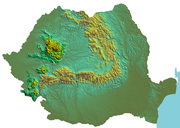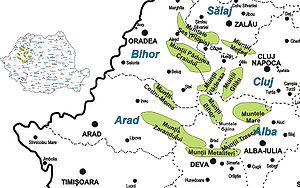
Apuseni Mountains
Encyclopedia

Mountain range
A mountain range is a single, large mass consisting of a succession of mountains or narrowly spaced mountain ridges, with or without peaks, closely related in position, direction, formation, and age; a component part of a mountain system or of a mountain chain...
in Transylvania
Transylvania
Transylvania is a historical region in the central part of Romania. Bounded on the east and south by the Carpathian mountain range, historical Transylvania extended in the west to the Apuseni Mountains; however, the term sometimes encompasses not only Transylvania proper, but also the historical...
, Romania
Romania
Romania is a country located at the crossroads of Central and Southeastern Europe, on the Lower Danube, within and outside the Carpathian arch, bordering on the Black Sea...
, which belongs to the Western Carpathians
Carpathian Mountains
The Carpathian Mountains or Carpathians are a range of mountains forming an arc roughly long across Central and Eastern Europe, making them the second-longest mountain range in Europe...
, also called Occidentali in Romanian. Their name translates from Romanian as Mountains "of the sunset" i.e. "western". The highest peak is "Cucurbăta Mare" - 1849 metres, also called Bihor Peak. The Apuseni Mountains have about 400 cave
Cave
A cave or cavern is a natural underground space large enough for a human to enter. The term applies to natural cavities some part of which is in total darkness. The word cave also includes smaller spaces like rock shelters, sea caves, and grottos.Speleology is the science of exploration and study...
s.
Geography
The Apuseni Mountains do not present an uninterrupted chain of mountains, but possess many low and easy passes towards the CrişanaCrisana
Crișana is a geographical and historical region divided today between Romania and Hungary, named after the Criș River and its three tributaries: the Crișul Alb, Crișul Negru and Crișul Repede....
and the Great Hungarian Plain
Great Hungarian Plain
The Great Hungarian Plain is a plain occupying the southern and eastern part of Hungary, some parts of the Eastern Slovak Lowland, southwestern Ukraine, the Transcarpathian Lowland , western Romania , northern Serbia , and eastern Croatia...
. Going from south to north the principal groups are: the Munţii Metaliferi ("Ore Mountains") with the basalt
Basalt
Basalt is a common extrusive volcanic rock. It is usually grey to black and fine-grained due to rapid cooling of lava at the surface of a planet. It may be porphyritic containing larger crystals in a fine matrix, or vesicular, or frothy scoria. Unweathered basalt is black or grey...
ic mass of the Detunata (1148 metres (3,766.4 ft)) near Abrud; the Bihor Mountains
Bihor Mountains
Bihor Mountains is a mountain range in western Romania. It is part of the Apuseni Mountains, which are part of the Carpathian Mountains. The massif has a length of 25 km from the northwest to the southeast and a width of 14 km...
, with romantic scenery and numerous cave
Cave
A cave or cavern is a natural underground space large enough for a human to enter. The term applies to natural cavities some part of which is in total darkness. The word cave also includes smaller spaces like rock shelters, sea caves, and grottos.Speleology is the science of exploration and study...
rns, with the highest peak the Curcubăta Mare (1843 metres (6,046.6 ft)); to the east of this group are the Muntele Mare (highest peak 1820 metres (5,971.1 ft)), to the southwest of Cluj-Napoca; the northermost chain is the Seş and Meseş Mountains.
Boundaries
- to the north: the Barcău RiverBarcau River (Cris)The Barcău River or Bereteu River is a river which has its origin in Sălaj County, Romania. It has a length of 134 kilometers and a watershed area of 2,025 km²...
- to the south: the Mureş RiverMures RiverThe Mureș is an approximately 761 km long river in Eastern Europe. It originates in the Hășmașu Mare Range in the Eastern Carpathian Mountains, Romania, and joins the Tisza river at Szeged in southeastern Hungary....
- to the east: the Transylvanian PlateauTransylvanian PlateauThe Transylvanian Plateau is a plateau in central Romania.The plateau lies within and takes its name from the historical region of Transylvania, and is almost entirely surrounded by the Eastern, Southern and Romanian Western branches of the Carpathian Mountains...
- to the west: the CrişanaCrisanaCrișana is a geographical and historical region divided today between Romania and Hungary, named after the Criș River and its three tributaries: the Crișul Alb, Crișul Negru and Crișul Repede....
plains
Subdivisions


- Criş Hills (Dealurile Crişene,), incl. Beiuş Depression (Depresiunea Beiuş), Vad Depression (Depresiunea Vad)
- Pădurea Craiului Mountains (literally:Forest of the King)
- Codru-Moma MountainsCodru-Moma MountainsThe Codru-Moma Mountains are a part of the Criş Mountains in the Apuseni Mountains in the Western Romanian Carpathians of Transylvania, Romania.-References:...
(Munţii Codru-Moma)
Seş-Meseş Mountains (Munţii Seş-Meseşului):
- Meseş Mountains (Munţii Meseşului)
- Seş Mountains (Muntele Seş, , also Plopiş)
- Şimleu Depression (Depresiunea Şimleu Silvanei, ), often considered part of the Transylvanian Basin-Podişul Someşan
- Şimleu Mountains (Munţii Şimleu), often considered part of the Transylvanian Basin-Podişul Someşan
Bihor Massif (Masivul Bihor):
- Bihor MountainsBihor MountainsBihor Mountains is a mountain range in western Romania. It is part of the Apuseni Mountains, which are part of the Carpathian Mountains. The massif has a length of 25 km from the northwest to the southeast and a width of 14 km...
(
Mureş Mountains (Munţii Mureşului):
- Zarand Mountains (Munţii Zarandului)
- Metalliferous Mountains (Munţii Metaliferi), incl. Trascău MountainsTrascau MountainsThe Trascău Mountains are located in the Apuseni mountain range of the Western Romanian Carpathians, in Romania.The Trascău Mountains are crossed by picturesque Arieş River valley...
(Munţii Trascăului)

